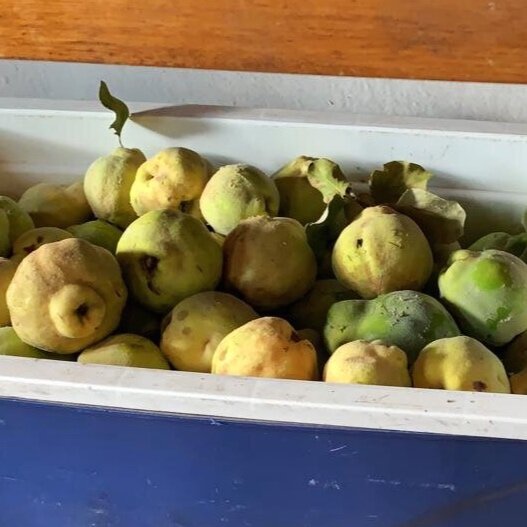Inside all bakeries in Argentina, there are glass display cases overflowing with coconut-rimmed tarts filled with glistening, red jam. These are all made using 'dulce de membrillo’, which is a quince paste. The Begg’s fondly remember their grandmother, making quince jelly and paste at Potrero de Niz when they were children. Tying a tea towel around the legs of a chair she would construct a sieve to drain the quince separating the paste from the jelly. Inedible raw quinces look like a cross between a pear and a golden apple, once cooked they turn sweet, with a vibrant red colour and have an incredible floral smell and taste.
Quince Jelly
1.5kg quince, chopped roughly
1 lemon, zest peeled into strips, juiced
900g sugar
Put the quince and lemon peel and juice in a large, deep saucepan. Cover with water (you'll need about 3 litres) and bring to the boil.
Reduce to a simmer and cook for 90 minutes until the quince is very soft.
Line a colander with muslin cloth and put over a very large saucepan or heatproof bowl. Tip the quince into the lined colander, cover with a clean tea towel and leave to strain for 4-8 hrs until all the juice has dripped out.
Keep the pulp for making ‘dulce de membrillo’. Measure out the strained juice and transfer to a large, deep saucepan (the jelly will bubble up high as it cooks). Add 500g sugar for every 600ml juice. Bring to the boil over a low heat, stirring to dissolve the sugar.
Bring to a rapid bubble and cook until the temperature reaches 105ºC/221ºF on a sugar thermometer. Remove from the heat and ladle into hot sterilized jars and seal.
Dulce de Membrillo
Making membrillo is extremely easy.
Take the quince pulp from the jelly and blend until smooth. Weigh the puree then put it in a large pot. Add an equal amount of granulated sugar to the mixture and place over a low heat. Stir the mixture constantly at first to dissolve the sugar, keep cooking until the mixture becomes thick (approx 1-2 hours). Once the mixture has thickened, it will stick to a wood spoon.
Line a baking dish or lightly grease before pouring in the quince mixture. Allow the paste to cool, before placing in the oven on the lowest heat, dry the paste out (this can take up to three hours, if it has not set keep it in the oven checking it regularly). The surface should be glossy and not sticky to touch. Put the dish in the fridge and refrigerate overnight.



